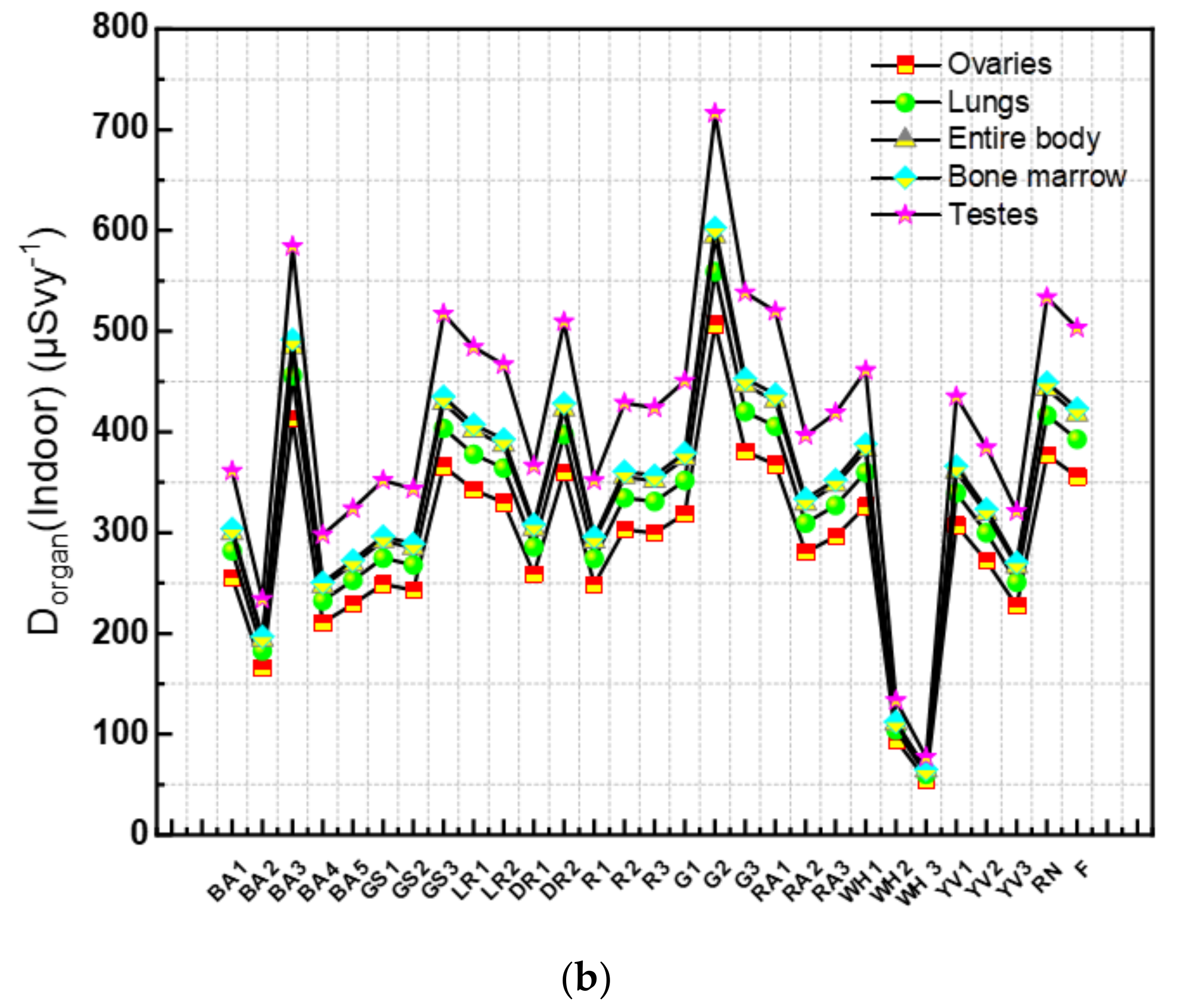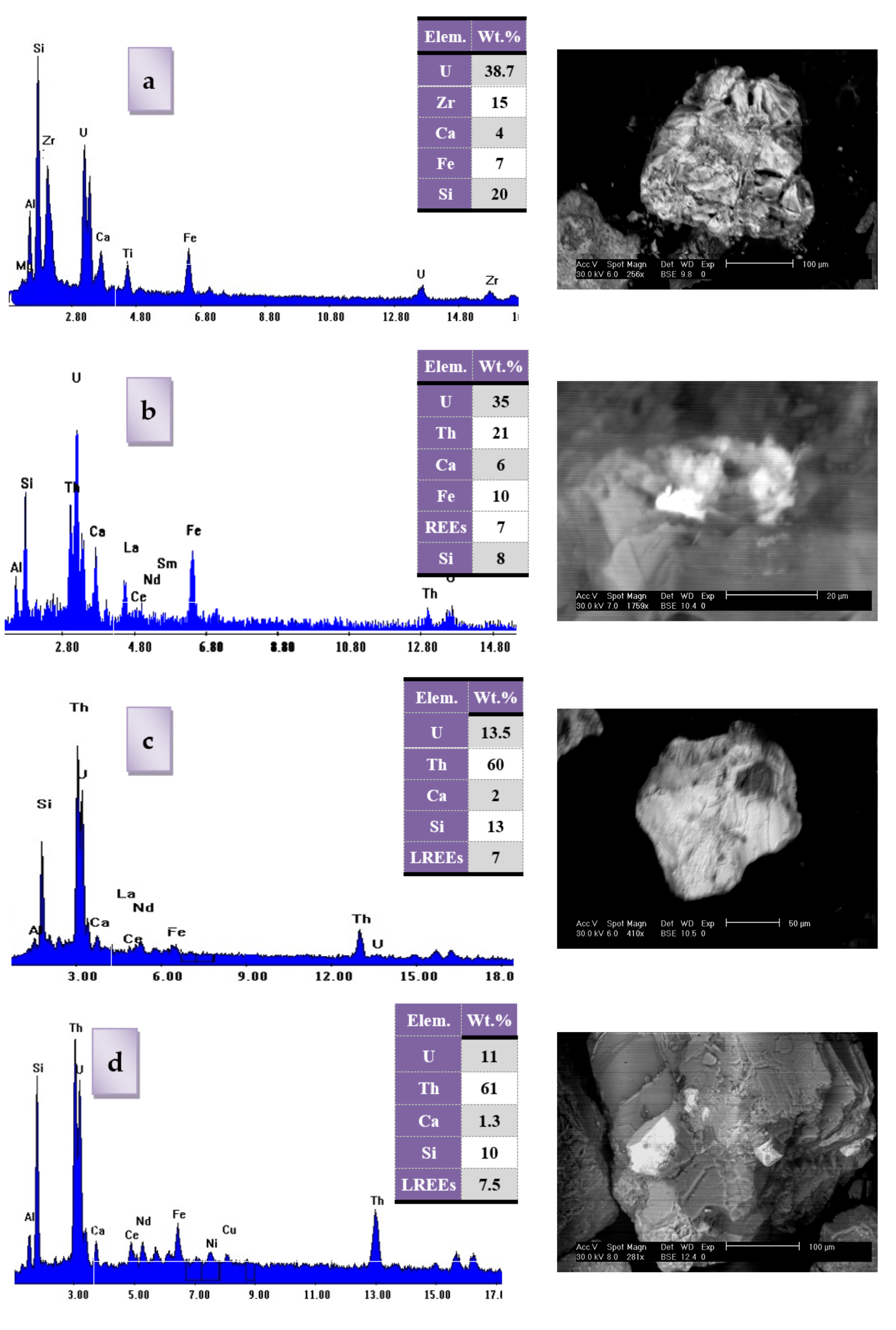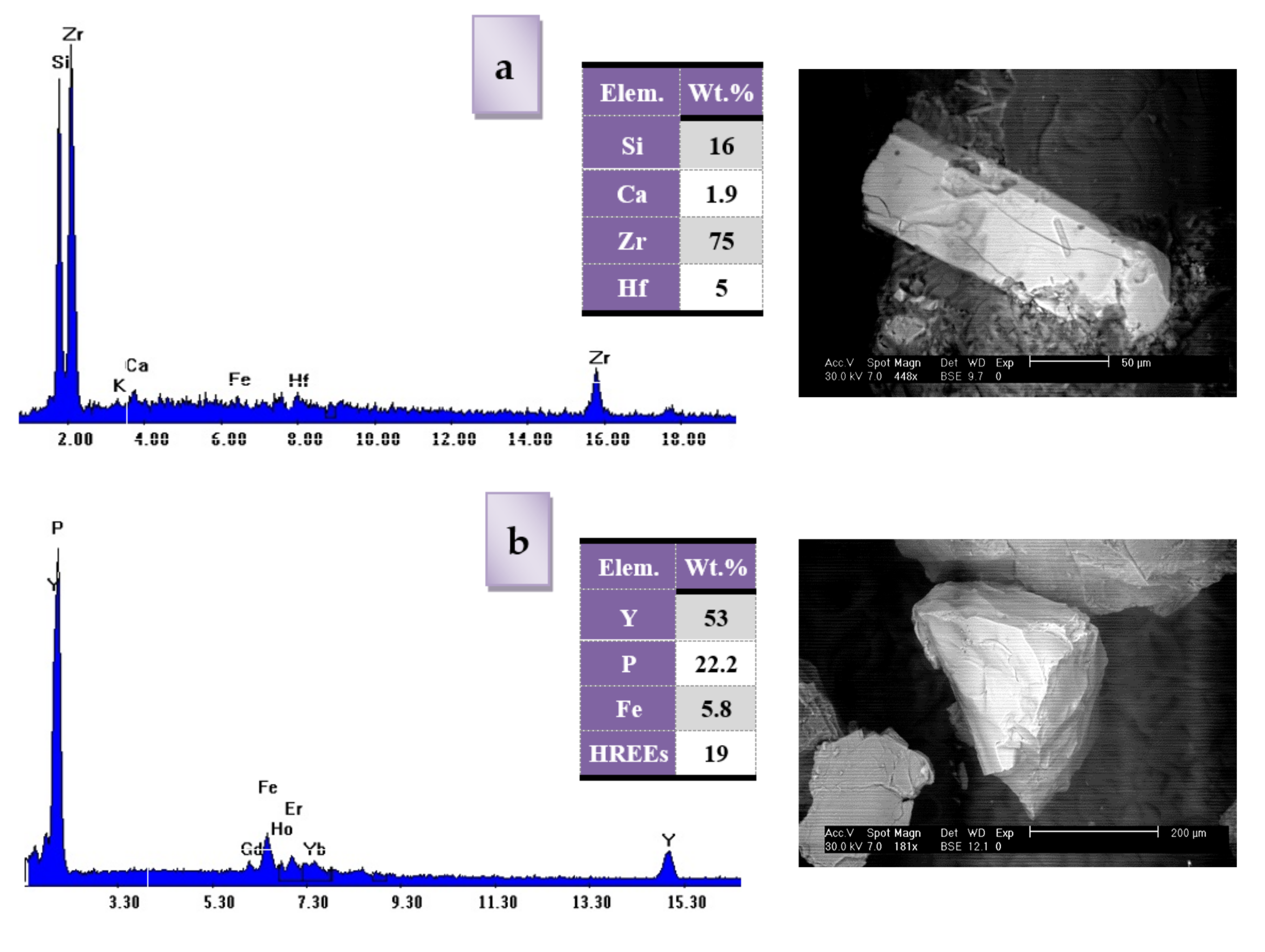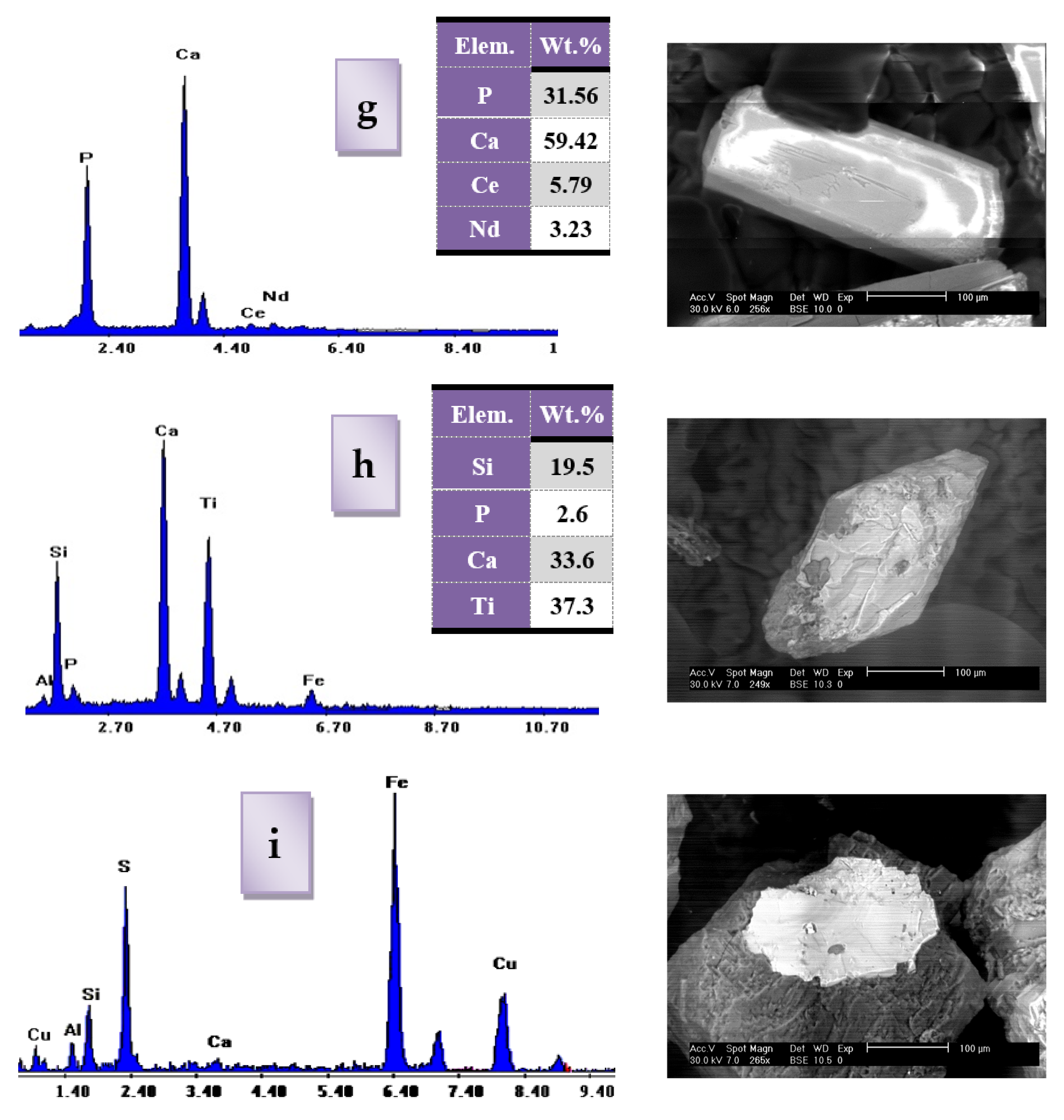Analysis of the Radiological, Mineralogical and Long-Term Sustainability of Several Commercial Aswan Granites Used as Building Materials
Abstract
:1. Introduction
2. Materials and Methods
3. Statistical Study of Measured Results of 232Th/238U, K-40, Ra-226, Th-232, and U-238
4. Theoretical Calculations of Radiological Hazards Indices
5. Results
5.1. Radiological Impact
5.2. Radionuclide’s Activity Concentrations Contributing to the Absorbed Dose Rate
5.3. Mineralogical Investigation Results
5.3.1. Radioactive Minerals
5.3.2. Accessory Minerals
- Aeschynite-(Y) the yttrium rich aeschynite.
- Aeschynite-(Ce) the cerium rich aeschynite.
- Aeschynite-(Nd) the neodymium rich aeschynite.
5.4. Statistical Study for Raeq and Absorbed Dose, AEDE_in, AEDE_out, ELCR, and AGDE
6. Conclusions
- This study carried out statistical analyses on the radiological measurements results, such as the Pearson correlation, T-Test, Mann–Whitney Test, and Kruskal–Wallis Test. Descriptive statistics and graphic representations are also presented.
- The level of natural radioactivity of the investigated granites relates to the presence of both the K-rich minerals (Kefeldspars, biotite) and accessories such as uranophane, uranothorite, allanite, xenotime, fergusonite, aeschynite, zircon, cassiterite, apatite, and sphene, which are mainly found in granitic rocks.
- For most of the rock samples examined, the indicators of radiological hazards are within the permissible level range, which indicates the recommendation for use as a building material. On the other hand, some samples have environmental levels higher than the international levels, which indicates that they are not suitable for use as building materials because of radioactive bearing minerals, such as uranophane and uranothorite.
- It can be concluded that advanced statistical approaches are remarkable tools in addition to experimental methods, owing to their reliable outcomes.
Author Contributions
Funding
Institutional Review Board Statement
Informed Consent Statement
Acknowledgments
Conflicts of Interest
References
- Ravisankar, R.; Sivakumar, S.; Chandrasekaran, A.; Prince Prakash Jebakumar, J.; Vijayalakshmi, I.; Vijayagopal, P.; Venkatraman, B. Spatial distribution of gamma radioactivity levels and radiological hazard indices in the East Coastal sediments of Tamilnadu, India with statistical approach. Radiat. Phys. Chem. 2014, 103, 89–98. [Google Scholar] [CrossRef]
- Ravisankar, R.; Vanasundari, K.; Suganya, M.; Raghu, Y.; Rajalakshmi, A.; Chandrasekaran, A.; Sivakumar, S.; Chandramohan, J.; Vijayagopal, P.; Venkatraman, B. Multivariate statistical analysis of radiological data of building materials used in tiruvannamalai, tamilnadu, india. Appl. Radiat. Isot. 2014, 85, 114–127. [Google Scholar] [CrossRef] [PubMed]
- Ercit, T.S. Identification and alteration trends of granitic-pegmatite-hosted (Y,REE,U,Th)-(Nb,Ta,Ti) oxide minerals: A statistical approach. Can. Mineral. 2005, 43, 1291–1303. [Google Scholar] [CrossRef] [Green Version]
- Issa, S.A.M.; Uosif, M.A.M.; Abd El-Salam, L.M. Natural radionuclide concentrations in granite rocks in Aswan and Central-Southern Eastern Desert, Egypt and their radiological implications. Radiat. Prot. Dosimetry 2012, 150, 488–495. [Google Scholar] [CrossRef] [PubMed]
- Powell, B.A.; Hughes, L.D.; Soreefan, A.M.; Falta, D.; Wall, M.; DeVol, T.A. Elevated concentrations of primordial radionuclides in sediments from the Reedy River and surrounding creeks in Simpsonville, South Carolina. J. Environ. Radioact. 2007, 94, 121–128. [Google Scholar] [CrossRef] [Green Version]
- Rimsaite, J. The leaching of radionuclides and other ions during alteration and replacement of accessory minerals in radioactive rocks. Pap. Geol. Surv. Can. 1982, 82, 253–266. [Google Scholar]
- Anjos, R.M.; Veiga, R.; Soares, T.; Santos, A.M.A.; Aguiar, J.G.; Frascá, M.H.B.O.; Brage, J.A.P.; Uzêda, D.; Mangia, L.; Facure, A.; et al. Natural radionuclide distribution in Brazilian commercial granites. Radiat. Meas. 2005, 39, 245–253. [Google Scholar] [CrossRef]
- Örgün, Y.; Altinsoy, N.; Gültekin, A.H.; Karahan, G.; Çelebi, N. Natural radioactivity levels in granitic plutons and groundwaters in Southeast part of Eskisehir, Turkey. Appl. Radiat. Isot. 2005, 63, 267–275. [Google Scholar] [CrossRef]
- Tzortzis, M.; Tsertos, H.; Christofides, S.; Christodoulides, G. Gamma radiation measurements and dose rates in commercially-used natural tiling rocks (granites). J. Environ. Radioact. 2003, 70, 223–235. [Google Scholar] [CrossRef] [Green Version]
- Norvegica, E.S.-P. Undefined Some Aspects on Radioactivity of Building Materials. Phys. Norv. 1976, 8, 163–167. Available online: https://inis.iaea.org/collection/NCLCollectionStore/_Public/11/546/11546783.pdf#page=56 (accessed on 23 February 2022).
- Lee, E.M.; Menezes, G.; Finch, E.C. Natural radioactivity in building materials in the Republic of Ireland. Health Phys. 2004, 86, 378–383. [Google Scholar] [CrossRef] [PubMed]
- Papadopoulos, A.; Christofides, G.; Koroneos, A.; Stoulos, S.; Papastefanou, C. Natural radioactivity and dose assessment of granitic rocks from the Atticocycladic Zone (Greece). Period. Mineral. 2012, 81, 301–311. [Google Scholar] [CrossRef]
- Jaupart, C.; Mareschal, J.C.; Bouquerel, H.; Phaneuf, C. The building and stabilization of an Archean Craton in the Superior Province, Canada, from a heat flow perspective. J. Geophys. Res. Solid Earth 2014, 119, 9130–9155. [Google Scholar] [CrossRef]
- da Costa, F.P.; Fernandes, J.V.; de Melo, L.R.L.; Rodrigues, A.M.; Menezes, R.R.; Neves, G.D.A. The Potential for Natural Stones from Northeastern Brazil to Be Used in Civil Construction. Minerals 2021, 11, 440. [Google Scholar] [CrossRef]
- Awad, H.A.; Zakaly, H.M.H.; Nastavkin, A.V.; El-Taher, A. Radioactive content in the investigated granites by geochemical analyses and radiophysical methods around Um Taghir, Central Eastern Desert, Egypt. J. Phys. Conf. Ser. 2020, 1582, 12007. [Google Scholar] [CrossRef]
- Tene, T.; Vacacela Gomez, C.; Tubon Usca, G.; Suquillo, B.; Bellucci, S. Measurement of radon exhalation rate from building materials: The case of Highland Region of Ecuador. Constr. Build. Mater. 2021, 293, 123282. [Google Scholar] [CrossRef]
- Moghazy, N.M.; El-Tohamy, A.M.; Fawzy, M.M.; Awad, H.A.; Zakaly, H.M.H.; Issa, S.A.M.; Ene, A. Natural radioactivity, radiological hazard and petrographical studies on aswan granites used as building materials in Egypt. Appl. Sci. 2021, 11, 6471. [Google Scholar] [CrossRef]
- Papadopoulos, A.; Christofides, G.; Koroneos, A.; Papadopoulou, L.; Papastefanou, C.; Stoulos, S. Natural radioactivity and radiation index of the major plutonic bodies in Greece. J. Environ. Radioact. 2013, 124, 227–238. [Google Scholar] [CrossRef]
- Malczewski, D.; Teper, L.; Dorda, J. Assessment of natural and anthropogenic radioactivity levels in rocks and soils in the environs of Swieradow Zdroj in Sudetes, Poland, by in situ gamma-ray spectrometry. J. Environ. Radioact. 2004, 73, 233–245. [Google Scholar] [CrossRef]
- Said, A.F.; Salam, A.M.; Hassan, S.F.; Mohamed, W.S. EG1100465 Assessment of the Environmental Radioactivity Impacts and Health Hazards Indices at Wadi Sahu Area, Sinai, Egypt. In Proceedings of the Tenth Radiation Physics and Protection Conference, Cairo, Egypt, 27–30 November 2010; pp. 27–30. [Google Scholar]
- Zakaly, H.M.H.; Uosif, M.A.M.; Issa, S.A.M.; Tekin, H.O.; Madkour, H.; Tammam, M.; El-Taher, A.; Alharshan, G.A.; Mostafa, M.Y.A. An extended assessment of natural radioactivity in the sediments of the mid-region of the Egyptian Red Sea coast. Mar. Pollut. Bull. 2021, 171, 112658. [Google Scholar] [CrossRef]
- Zakaly, H.M.; Uosif, M.A.; Madkour, H.; Tammam, M.; Issa, S.; Elsaman, R.; El-Taher, A. Assessment of natural radionuclides and heavy metal concentrations in marine sediments in view of tourism activities in Hurghada city, northern Red Sea, Egypt. J. Phys. Sci. 2019, 30, 21–47. [Google Scholar] [CrossRef]
- Beretka, J.; Mathew, P.J. Natural radioactivity of australian building materials, industrial wastes and by-products. Health Phys. 1985, 48, 87–95. [Google Scholar] [CrossRef] [PubMed]
- Yang, J.K.; Kim, W.S.; Park, H.H. Chemical bonding states and energy band gap of SiO2-incorporated La2O3 films on n-GaAs (001). Thin Solid Film. 2006, 494, 311–314. [Google Scholar] [CrossRef]
- UNSCEAR. Sources and Effects of Ionizing Radiation, United Nations Scientific Committee on the Effects of Atomic Radiation UNSCEAR 2000 Report to the General Assembly, with Scientific Annexes; UNSCEAR: New York, NY, USA, 2000; ISBN 92-1-142238-8. [Google Scholar]
- Hamzah, Z.; Saat, A.; Hayati Mashuri, N.; Datul Redzuan, S. Surface radiation dose and radionuclide measurement in ex-tin mining area, Kg Gajah, Perak. Malays. J. Anal. Sci. 2008, 12, 419–431. [Google Scholar]
- Nada, A. Evaluation of Natural Radionuclides at Um-Greifat Area, Eastern Desert of Egypt. Appl. Radiat. Isot. 2003, 58, 275–280. [Google Scholar] [CrossRef]
- European Commission (EC). Radiological protection principles concerning the natural radioactivity of building materials—Radiation Protection. Eur. Comm. 1999, 112, 1–16. [Google Scholar]
- ICRP Publication 60: 1990 Recommendations of the International Commission on Radiological Protection; ICRP: Stockholm, Sweden, 1991; ISBN 0080411444.
- Tawfic, A.F.; Zakaly, H.M.H.; Awad, H.A.; Tantawy, H.R.; Abbasi, A.; Abed, N.S.; Mostafa, M. Natural radioactivity levels and radiological implications in the high natural radiation area of Wadi El Reddah, Egypt. J. Radioanal. Nucl. Chem. 2021, 327, 643–652. [Google Scholar] [CrossRef]
- Abed, N.S.; Monsif, M.A.; Zakaly, H.M.H.; Awad, H.A.; Hessien, M.M.; Yap, C.K. Assessing the Radiological Risks Associated with High Natural Radioactivity of Microgranitic Rocks: A Case Study in a Northeastern Desert of Egypt. Int. J. Environ. Res. Public Health 2022, 19, 473. [Google Scholar] [CrossRef]
- Xinwei, L. Natural radioactivity in some building materials and by-products of Shaanxi, China. J. Radioanal. Nucl. Chem. 2005, 262, 775–777. [Google Scholar] [CrossRef]
- El-Taher, A. Determination of chromium and trace elements in El-Rubshi chromite from Eastern Desert, Egypt by neutron activation analysis. Appl. Radiat. Isot. 2010, 68, 1864–1868. [Google Scholar] [CrossRef]
- El-Taher, A.; Zakaly, H.M.H.; Elsaman, R. Environmental implications and spatial distribution of natural radionuclides and heavy metals in sediments from four harbours in the Egyptian Red Sea coast. Appl. Radiat. Isot. 2018, 131, 13–22. [Google Scholar] [CrossRef] [PubMed]
- Heinrich, E.W. Mineralogy and Geology of Radioactive Raw Materials; McGraw-Hill Book Company: New York, NY, USA, 1958. [Google Scholar]
- Holland, H.D.; Gottfried, D. The effect of nuclear radiation on the structure of zircon. Acta Crystallogr. 1955, 8, 291–300. [Google Scholar] [CrossRef]
- Headley, J.V.; Mason, R.S.; Jennings, K.R. Kinetics, equilibria and diffusion of ions produced in N2, CO and CO2, studied as a function of temperature using a high-pressure pulsed mass spectrometer source. J. Chem. Soc. Faraday Trans. 1 Phys. Chem. Condens. Phases 1982, 78, 933–945. [Google Scholar] [CrossRef]








| Sig. (p-Value) | Test Statistics | Mean Rank | ||||
|---|---|---|---|---|---|---|
| 0.00 | 115.598 | 232Th/238U | K-40 | Ra-226 | Th-232 | U-238 |
| 15.28 | 131 | 58.76 | 84 | 75.97 | ||
| Sig. (p-Value) | Test Statistics (Z) | Mean Rank | |
|---|---|---|---|
| 0.272 | −1.098 | Th-232 | U-238 |
| 31.93 | 27.07 | ||
| 0.015 | −2.442 | Ra-226 | U-238 |
| 24.10 | 34.90 | ||
| 0.000 | −6.547 | K-40 | U-238 |
| 44 | 15 | ||
| 0.000 | −6.548 | 232Th/238U | U-238 |
| 15 | 44 | ||
| 0.000 | −3.937 | Ra-226 | Th-232 |
| 20.79 | 38.21 | ||
| 0.000 | −6.541 | K-40 | Th-232 |
| 44 | 15 | ||
| 0.000 | −6.480 | 232Th/238U | Th-232 |
| 15.14 | 43.86 | ||
| 0.000 | −6.554 | K-40 | Ra-226 |
| 44 | 15 | ||
| 0.000 | −6.493 | 232Th/238U | Ra-226 |
| 15.14 | 43.86 | ||
| 0.000 | −6.541 | 232Th/238U | K-40 |
| 15 | 44 | ||
| Sig (2-Tailed) | 232Th/238U | U-238 | Th-232 | Ra-226 | K-40 |
|---|---|---|---|---|---|
| 232Th/238U | 1 | −0.635 ** | 0.421 * | −0.230 | 0.407 * |
| U-238 | −0.635 ** | 1 | 0.28 | 0.724 ** | 0.050 |
| Th-232 | 0.421 * | 0.028 | 1 | 0.362 | 0.686 ** |
| Ra-226 | −0.230 | 0.724 ** | 0.362 | 1 | 0.268 |
| K-40 | 0.407 * | 0.050 | 0.686 ** | 0.268 | 1 |
| U-238 | Th-232 | Ra-226 | K-40 | 232Th/238U | |
|---|---|---|---|---|---|
| N | 29 | 29 | 29 | 29 | 29 |
| Mean | 52.17 | 57.82 | 31.17 | 1055.67 | 1.87 |
| Std. Deviation | 39.59 | 26.90 | 19.09 | 292.08 | 1.64 |
| Variance | 1567.66 | 723.69 | 364.39 | 85,309.23 | 2.68 |
| Skewness | 1.10 | −0.079 | 0.93 | −1.28 | 1.38 |
| Kurtosis | 0.29 | −0.58 | 1.31 | 2.06 | 1.52 |
| Activity | Radium Equivalent (Raeq) | Absorbed Dose Rate (DR) | Annual Effective Dose Equivalent (AEDE) (μSvy−1) | Hazard Indices (Hex and Hin) | Gamma Index (Iγ) | Activity Utilization Index (I) | Excess Lifetime Cancer Risk (ELCR) | Annual Gonadal Equivalent (AGDE) | ||
|---|---|---|---|---|---|---|---|---|---|---|
| Sample No: | (Bq/kg) | (nGy/h) | (Outdoor) | (Indoor) | Hex | Hin | (Iγ) | (I) | (ELCR) | (μSvy−1) |
| BA1 | 186.01 | 89.81 | 110.14 | 440.56 | 0.50 | 0.64 | 0.62 | 3.91 | 385.49 | 649.37 |
| BA2 | 120.49 | 58.18 | 71.35 | 285.39 | 0.33 | 0.36 | 0.40 | 2.50 | 249.72 | 425.53 |
| BA3 | 310.49 | 145.23 | 178.11 | 712.43 | 0.84 | 0.97 | 1.05 | 5.96 | 623.38 | 1043.04 |
| BA4 | 155.56 | 74.06 | 90.83 | 363.32 | 0.42 | 0.49 | 0.52 | 3.13 | 317.90 | 536.23 |
| BA5 | 171.29 | 80.52 | 98.75 | 395.00 | 0.46 | 0.53 | 0.58 | 3.33 | 345.62 | 580.26 |
| GS1 | 184.03 | 87.53 | 107.35 | 429.40 | 0.50 | 0.53 | 0.62 | 3.66 | 375.73 | 637.69 |
| GS2 | 180.54 | 85.39 | 104.72 | 418.89 | 0.49 | 0.65 | 0.61 | 3.62 | 366.53 | 608.19 |
| GS3 | 277.23 | 128.56 | 157.67 | 630.67 | 0.75 | 0.92 | 0.94 | 5.23 | 551.84 | 915.29 |
| LR1 | 259.78 | 120.37 | 147.63 | 590.50 | 0.70 | 0.80 | 0.88 | 4.86 | 516.69 | 861.84 |
| LR2 | 246.67 | 116.02 | 142.28 | 569.13 | 0.67 | 1.03 | 0.83 | 4.97 | 497.99 | 811.34 |
| DR1 | 192.28 | 91.06 | 111.67 | 446.69 | 0.52 | 0.59 | 0.65 | 3.80 | 390.85 | 659.15 |
| DR2 | 272.39 | 126.62 | 155.29 | 621.16 | 0.74 | 0.90 | 0.92 | 5.17 | 543.52 | 902.26 |
| R1 | 181.86 | 87.42 | 107.21 | 428.86 | 0.49 | 0.56 | 0.61 | 3.74 | 375.25 | 636.74 |
| R2 | 220.22 | 106.57 | 130.70 | 522.80 | 0.59 | 0.66 | 0.74 | 4.60 | 457.45 | 779.77 |
| R3 | 218.85 | 105.38 | 129.24 | 516.94 | 0.59 | 0.72 | 0.73 | 4.55 | 452.33 | 763.18 |
| G1 | 234.63 | 112.04 | 137.41 | 549.63 | 0.63 | 0.83 | 0.79 | 4.82 | 480.93 | 803.14 |
| G2 | 381.75 | 178.13 | 218.45 | 873.82 | 1.03 | 1.43 | 1.29 | 7.43 | 764.59 | 1256.14 |
| G3 | 285.26 | 133.83 | 164.13 | 656.54 | 0.77 | 1.07 | 0.96 | 5.63 | 574.47 | 946.20 |
| RA1 | 277.21 | 129.19 | 158.44 | 633.75 | 0.75 | 0.92 | 0.94 | 5.30 | 554.53 | 921.91 |
| RA2 | 204.76 | 98.57 | 120.89 | 483.54 | 0.55 | 0.59 | 0.69 | 4.20 | 423.10 | 722.22 |
| RA3 | 218.09 | 104.16 | 127.74 | 510.97 | 0.59 | 0.66 | 0.73 | 4.40 | 447.10 | 757.69 |
| WH1 | 244.10 | 114.61 | 140.56 | 562.23 | 0.66 | 0.71 | 0.83 | 4.70 | 491.95 | 829.62 |
| WH2 | 68.40 | 33.17 | 40.68 | 162.73 | 0.18 | 0.28 | 0.23 | 1.49 | 142.39 | 235.63 |
| WH3 | 40.11 | 19.21 | 23.56 | 94.23 | 0.11 | 0.14 | 0.13 | 0.83 | 82.45 | 137.95 |
| YV1 | 228.73 | 108.14 | 132.62 | 530.47 | 0.62 | 0.65 | 0.77 | 4.48 | 464.16 | 786.43 |
| YV2 | 198.96 | 95.55 | 117.19 | 468.74 | 0.54 | 0.84 | 0.66 | 4.23 | 410.15 | 674.73 |
| YV3 | 165.70 | 79.87 | 97.95 | 391.80 | 0.45 | 0.55 | 0.55 | 3.46 | 342.82 | 578.78 |
| RN | 277.48 | 132.65 | 162.69 | 650.75 | 0.75 | 1.08 | 0.93 | 5.77 | 569.41 | 942.49 |
| F | 265.11 | 125.07 | 153.39 | 613.56 | 0.72 | 0.92 | 0.89 | 5.26 | 536.86 | 893.89 |
| Test Statistics (t) | Degree of Freedom | Sample Mean | Sig (p-Value) | |
|---|---|---|---|---|
| Raeq | Absorbed Dose | |||
| 7.939 | 56 | 216.137 | 102.307 | 0.000 |
| Sig. (p-Value) | Test Statistics | Mean Rank | |||
|---|---|---|---|---|---|
| 0.000 | 76.291 | AEDE_in | AEDE_out | ELCR | AGDE |
| 66.45 | 17.55 | 56.41 | 93.59 | ||
| Sig. (p-Value) | Test Statistics (Z) | Mean Rank | |
|---|---|---|---|
| 0.000 | −6.104 | AEDE_out | AEDE_in |
| 15.97 | 43.03 | ||
| 0.065 | −1.843 | ELCR | AEDE_in |
| 25.41 | 33.59 | ||
| 0.000 | −4.362 | AGDE | AEDE_in |
| 39.17 | 19.83 | ||
| 0.000 | −5.995 | ELCR | AEDE_out |
| 42.79 | 16.21 | ||
| 0.000 | −6.368 | AGDE | AEDE_out |
| 43.62 | 15.38 | ||
| 0.000 | −5.093 | AGDE | ELCR |
| 40.79 | 18.21 | ||
| Sig. (p-Value) | Test Statistics | Mean Rank | |||
|---|---|---|---|---|---|
| 0.000 | 66.835 | Hazard_hin | Hazard_hex | Gamma_index | Activity_utiliz |
| 48.27 | 32.98 | 50.19 | 100.22 | ||
| Sig. (p-Value) | Test Statistics (Z) | Mean Rank | |
|---|---|---|---|
| 0.030 | −2.172 | Hazard_hin | Hazard_hex |
| 33.86 | 24.31 | ||
| 0.836 | −0.208 | Hazard_hin | Gamma_index |
| 28.54 | 29.45 | ||
| 0.000 | −6.314 | Hazard_hin | Activity_utiliz |
| 14.88 | 42.64 | ||
| 0.008 | −2.660 | Hazard_hex | Gamma_index |
| 23.60 | 35.40 | ||
| 0.000 | −6.509 | Hazard_hex | Activity_utiliz |
| 15.07 | 43.93 | ||
| 0.000 | −6.385 | Gamma_index | Activity_utiliz |
| 15.34 | 43.66 | ||
| Sig (2-Tailed) | Raeq | ABD_Dose | AEDE_In | AEDE_Out | Hazard_Hin | Hazard_Hex | Gamma_Index | Activity_Utiliz. | ELCR | AGDE |
|---|---|---|---|---|---|---|---|---|---|---|
| Raeq | 1 | 0.999 ** | 0.999 ** | 0.999 ** | 0.948 ** | 1.000 ** | 1.000 ** | 0.994 ** | 0.999 ** | 0.998 ** |
| Abd_dose | 0.999 ** | 1 | 1.000 ** | 1.000 ** | 0.948 ** | 0.999 ** | 0.999 ** | 0.997 ** | 1.000 ** | 0.999 ** |
| AEDE_in | 0.999 ** | 1.000 ** | 1 | 1.000 ** | 0.948 ** | 0.999 ** | 0.999 ** | 0.997 ** | 1.000 ** | 0.999 ** |
| AEDE_out | 0.999 ** | 1.000 ** | 1.000 ** | 1 | 0.948 ** | 0.999 ** | 0.999 ** | 0.997 ** | 1.000 ** | 0.999 ** |
| Hazard_hin | 0.948 ** | 0.948 ** | 0.948 ** | 0.948 ** | 1 | 0.948 ** | 0.946 ** | 0.957 ** | 0.948 ** | 0.999 ** |
| Hazard_hex | 1.000 ** | 0.999 ** | 0.999 ** | 0.999 ** | 0.948 ** | 1 | 1.000 ** | 0.993 ** | 0.999 ** | 0.936 ** |
| Gamma_index | 1.000 ** | 0.999 ** | 0.999 ** | 0.999 ** | 0.946 ** | 1.000 ** | 1 | 0.992 ** | 0.999 ** | 0.997 ** |
| Activity_utiliz. | 0.994 ** | 0.997 ** | 0.997 ** | 0.997 ** | 0.957 ** | 0.993 ** | 0.992 ** | 1 | 0.997 ** | 0.996 ** |
| ELCR | 0.999 ** | 1.000 ** | 1.000 ** | 1.000 ** | 0.948 ** | 0.999 ** | 0.999 ** | 0.997 ** | 1 | 0.999 ** |
| AGDE | 0.998 ** | 0.999 ** | 0.999 ** | 0.999 ** | 0.936 ** | 0.998 ** | 0.997 ** | 0.996 ** | 0.999 ** | 1 |
Publisher’s Note: MDPI stays neutral with regard to jurisdictional claims in published maps and institutional affiliations. |
© 2022 by the authors. Licensee MDPI, Basel, Switzerland. This article is an open access article distributed under the terms and conditions of the Creative Commons Attribution (CC BY) license (https://creativecommons.org/licenses/by/4.0/).
Share and Cite
Zakaly, H.M.H.; Awad, H.A.; Moghazy, N.M.; Tekin, H.O.; Rabie, A.; Fawzy, M.M.; El-Tohamy, A.M.; Ene, A.; Issa, S.A.M. Analysis of the Radiological, Mineralogical and Long-Term Sustainability of Several Commercial Aswan Granites Used as Building Materials. Sustainability 2022, 14, 3553. https://doi.org/10.3390/su14063553
Zakaly HMH, Awad HA, Moghazy NM, Tekin HO, Rabie A, Fawzy MM, El-Tohamy AM, Ene A, Issa SAM. Analysis of the Radiological, Mineralogical and Long-Term Sustainability of Several Commercial Aswan Granites Used as Building Materials. Sustainability. 2022; 14(6):3553. https://doi.org/10.3390/su14063553
Chicago/Turabian StyleZakaly, Hesham M. H., Hamdy A. Awad, Nasser M. Moghazy, Huseyin O. Tekin, Abdalla Rabie, Mona M. Fawzy, Amira M. El-Tohamy, Antoaneta Ene, and Shams A. M. Issa. 2022. "Analysis of the Radiological, Mineralogical and Long-Term Sustainability of Several Commercial Aswan Granites Used as Building Materials" Sustainability 14, no. 6: 3553. https://doi.org/10.3390/su14063553
APA StyleZakaly, H. M. H., Awad, H. A., Moghazy, N. M., Tekin, H. O., Rabie, A., Fawzy, M. M., El-Tohamy, A. M., Ene, A., & Issa, S. A. M. (2022). Analysis of the Radiological, Mineralogical and Long-Term Sustainability of Several Commercial Aswan Granites Used as Building Materials. Sustainability, 14(6), 3553. https://doi.org/10.3390/su14063553










